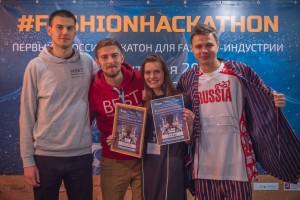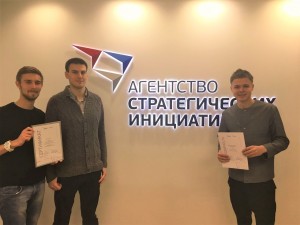June 14, 2018, the opening match of the 2018 Football world cup. You sit at the Luzhniki stadium in Moscow, wearing a t-shirt with the Russian flag on it, and you loudly support your national team. 20 minutes into the game and it’s a goal for Russia! You can feel the excitement in your heart, but also in your body. Your shirt is vibrating and the Russian flag on it is replaced with the word “GOAL!” in flashing colors. Does this sound like a dream to you? In less than two years, this may be a reality that will change the way sports fans show their support.
Skoltech students won the first prize in a fashion hackathon that was held last month. The students, Pavel Sukhov, Oleg Shipitko, and Marko Simic, all from Skoltech’s Robotics lab, featured a very unique t-shirt for sports fans.
Their project, named “Feel the Field” uses wearable tech to take the football spectator experience to a whole different level. Their t-shirts have an embedded LED display, which is connected to ios/android application, through which, the user can choose what image to display – his team’s logo, mascot, a written message etc. “Feel the Field” also enables multi-user collaborations. Fans wearing these shirts can create an interactive display that is shown on them.
The Fashion Hackathon consisted of two tracks: Fashion Wearable and E-commerce. Skoltech’s team “Refuge” got the first prize in the Fashion Wearable track, as well as one more nomination called Promising Market.
The success in the fashion hackathon was the icing on the cake for our students. Just a little bit before that, team Refuge gave there a more serious pitch-session in front of leaders of industry at the Agency for Strategic Initiatives. In this event they also got one of the two winning nominations.
“While it is impossible to estimate the technological level and the prospects of commands, since the teams had too little time, there was an exception: team Refuge. They did a very good and cool work in just two weeks! Their idea is good and they have an understanding of who they sell to. The fact that in such a short time they managed to produce a prototype worth showing, is an indicator for a good team.” Complimented Alexander Gorny, the CIO of Mail.ru, who was one of the experts participating in the event.
Professor Dzmitry Tsetserukou, head of Skoltech’s Robotics Lab, commented about his students’ achievement: “The “Feel the Field” project is just fascinating and impressing. Not only that I like the idea, but I really want to wear it. Conceptually, I see two catchy features that people will enjoy: The first one is that the group of hundreds of standing fans, let us call it pixel, can produce huge crowd image of e.g. flag of the team, face of the player, animated text. Deep psychological connections between the members of the fan club can be built using the device. The second one is the touch feedback that fully immerse the spectacular to the play and gives emotionally charged connection with the game. With the touch sensation on the chest user can experience the ball motion on the field, goal event, and human wave direction. This is the part of the Affective Haptics technology that was proposed by me in 2009. It aims to control and send the emotions to the humans through the tactile channel. In the case of “Feel the Field”, the user can experience the charged emotions of the game!”



